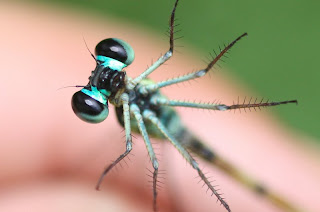Number: ---
Family: Lestidae
Genus: Lestes
Species: Lestes thoracicus
Common name(s): N/A
Thai name(s): N/A
Habitat: Lowland areas, often seemingly void of a water body
Province(s) sighted: My back garden! and a few other places so widespread (Khon Kaen)
Sightings (by me): Uncommon
In flight (that I have seen): April-November (possibly year-round)
Common name(s): N/A
Thai name(s): N/A
Habitat: Lowland areas, often seemingly void of a water body
Province(s) sighted: My back garden! and a few other places so widespread (Khon Kaen)
Sightings (by me): Uncommon
In flight (that I have seen): April-November (possibly year-round)
So the new species keep coming... even when I'm not doing anything! Lestes thoracicus, a species I didn't know I had photographed nor did I know it resided in Khon Kaen and even my back garden for that matter! I always thought that this was mature L. concinnus until Oleg Kosterin pointed out that it is, in fact, as different species altogether.
Oleg commented on the species (when I had it identified it as mature L. concinnus): "Quite a time ago I was striken by your photos as I never heard L. concinnus gets blueish or greenish. Asahina describes it as "an entirely pale brownish tinted insect", and so I saw it many times. Also the broad dark dorsal stripe in the 'adult male' is strange. What I am trying to say: the bluish ones [whilst on my previous blog with a mix of 2 species] are Lestes thoracicus Laidlaw. I see two characteristic dots on the metepisternum of the prothorax. Asahina points at these dots and describes the colour as 'bluish olive' and wrote 'abdomen mat black dorsally' for the male, isn't this so in yours? What is also characteristic for the species: the pterostigma dark inside and light outside."
Well, that's me all excited again! I'm going to go out this weekend around Khon Kaen for a change and try to find out more abut the habitat of this species.
The male
The male is about the same size as L. concinnus, but its obvious difference is its colour.
The female
The female is identical to the male, but is slightly more robust. I need to look for more photos of the female in my archives (I'm sure I have some, somewhere).
The female ... close up
Another female basking in the late after noon sun.
In the past, I used to search for this species often. I found 1 male, but then didn't spot another for a long time. Then, one day, I was out in the back garden (very small, but was overgrown with weeds at the time), I noticed 2 males and a female and I still haven't found a water source closer than 1 km. So, I have no idea why they were there. Bear in mind I live on an estate surrounded by many houses. Maybe they were resting. I have also spotted 2 males near small farmer's ponds, surrounded by flat, baron landscape. I need to search the area more thoroughly to give a more accurate description of habitat.
That now means that I have spotted and photographed 4 species from the Lestidae family in Khon Kaen province: Lestes elatus, Lestes concinnus, Lestes thoracicus and Orolestes octomaculata, which I saw at Phu Wiang NP, Khon Kaen earlier this year.
Once again, Many many thanks to Oleg Kosterin for correcting my identification and providing information regarding the species.




















































